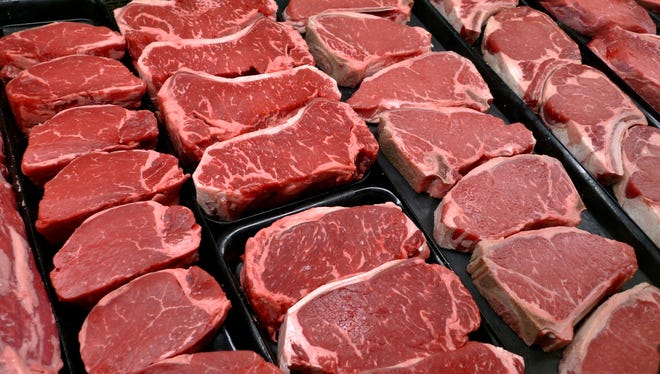In the Us Are There Labels for Tenderized Beef

- Mechanically tenderizing beef can drive disease-causing agents deep inside
- Government hasn%27t required producers to label mechanically tenderized meat
- The USDA says consumers should know what they%27re getting when they buy tenderized meat
After years of food-safety concerns and at least five outbreaks of illness, the U.S. Department of Agriculture is proposing that mechanically tenderized meat — 26% of all the beef sold in the USA — be labeled as such and that labels include cooking instructions.
Tenderizing meat mechanically involves forcing hundreds of tiny blades or needles through it to break up muscle fibers and make it more tender.
Unfortunately, it can also drive pathogens that might be on the surface, such as E. coli O157:H7, deep into the cut's interior, where cooking may not kill them. According to the Centers for Disease Control and Prevention, there have been five E. coli outbreaks attributed to mechanically tenderized beef, sickening 174 people. Four died.
E. coli and other bacteria live in the guts of cattle, pigs and other animals. When the animals are slaughtered, manure can end up on the carcass despite heat treatment and washing. In intact cuts such as steaks and roasts, the external heat of cooking is enough to kill stray bacteria. When beef is ground, the bacteria on the outside can end up inside a patty. If it isn't cooked all the way through, to an internal temperature of 160 degrees, the bacteria can survive and cause illness.
Several outbreaks of E. coli O157:H7 from hamburgers led the USDA to require testing of ground beef, as well as efforts to convince Americans to cook their burgers thoroughly. Even though blade- and needle-tenderized beef carries much the same danger, it is not required to be labeled.
It's impossible to tell just by looking that a cut of meat has undergone mechanical tenderization, said USDA Undersecretary Elisabeth Hagen.
"When people buy cube steak, you see the marks where the machinery has cubed up the steak," Hagen said. "When people buy ground beef, they know they're getting ground product. But when people order this product, they don't know. And certainly, when people are ordering in a restaurant, they don't know they're ordering this product."
She added, "A lot of people want a medium-rare steak. But if folks knew that the steak they're buying might not be what they think it is, and might be in a higher risk category," they might want it well done.
Some stores do label the product. Costco labels mechanically tenderized beef it sells as "blade tenderized."
Until now, the USDA hadn't required producers to label mechanically tenderized meat so consumers know what they're buying. The new rules, to be announced Thursday, would require that mechanically tenderized products be labeled. The labels would include cooking instructions.
Hagen said mechanically tenderized meat should be cooked to an internal temperature of at least 145 degrees, then allowed to sit for at least three minutes after it is taken off the heat to insure any potential pathogens are killed.
The rules are subject to a comment period before they can take effect. The USDA aims to implement the final version next year.
Americans prefer tender beef. According to a survey by the National Cattlemen's Beef Association, a tender cut of meat can sell for five times the price of a less tender cut the same size.
Canada has rules in the works to require labeling of mechanically tenderized meat. Last October, an outbreak of E. coli O157:H7 linked to meat processor XL Foods sickened 18 people and led to the country's largest beef recall, almost 2.5 million pounds of meat. Some of it was mechanically tenderized.
Some food-safety specialists aren't sure labeling would make much difference.
"We can't get people to use thermometers on steaks. Why would they do it for needle-tenderized meat?" said Doug Powell, a professor of food safety at Kansas State University in Manhattan, Kan.
Cooking blade-tenderized meat to 145 degrees, the temperature required to kill E. coli, would "turn it into a hockey puck," Powell said. "Why would someone pay the premium for steak or roast and then turn it into a hockey puck?"
Source: https://www.usatoday.com/story/news/nation/2013/06/06/usda-label-mechanically-tenderized-meat/2390875/#:~:text=Until%20now%2C%20the%20USDA%20hadn,labels%20would%20include%20cooking%20instructions.
0 Response to "In the Us Are There Labels for Tenderized Beef"
Postar um comentário